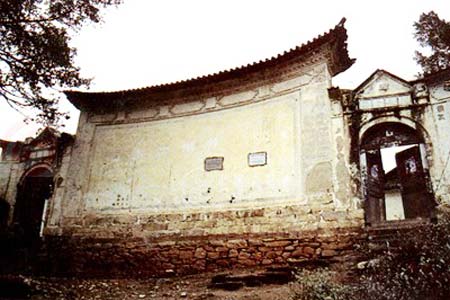
The Chieftain Government Office of TuE Town in Lanping County, Nujiang
Overview
The Chieftain Government Office of TuE Town, known as Tù’é Tǔsī Yáshǔ (兔峨土司衙署), began construction in the first year of the Republic of China (民国元年, 1912). It is situated on a small hill southeast of the TuE River (兔峨河) and on the west bank of the Lancang River (澜沧江). The building faces south and features a traditional Bai ethnic (白族) residential style, consisting of a single entry with two courtyards, four wings, and five patios.
In 1998, it was recognized by the Yunnan Provincial Government (云南省人民政府) as a provincial-level cultural relic protection unit.
- Chinese Name: 兔峨土司衙署 (Tù’é Tǔsī Yáshǔ)
- Location: Yunnan Province, Nujiang Lisu Autonomous Prefecture, Lanping County, TuE Town (云南省怒江傈僳族自治州兰坪县兔峨乡)
- Area: 900 m²
- Protection Level: Provincial-level cultural relic protection unit (云南省第五批省级文物保护单位)
Architectural Features
The Chieftain Government Office is adorned with intricately carved beams and painted eaves, showcasing its grandeur. The courtyard layout is well-organized, with a total of 54 rooms occupying an area of 990 m². The exterior walls are adorned with poetry, resembling a gallery of art. Surrounding the office are lush fruit trees and the melodious sounds of birds and flowers.
The main hall served as the office for the chieftain and housing for family members, with a guardhouse at the entrance. After 1951, the TuE Grain Depot operated within the office, converting parts of the structure into storage facilities. Although the windows and doors have changed, the main building and its exterior remain well-preserved, making it the only Bai chieftain’s office in the country to retain its original form.
In January 1958, the Lanping County Government allocated 55,000 yuan to assist the descendants of Luo Xing (罗星), the last chieftain, transitioning the office to government ownership. On June 20, 1986, it was designated a key cultural relic protection unit by the Lanping County Government. In 1989, it was placed under the management of the TuE Town Government, which also established a cultural center within its premises.
In February 2000, with support from the Yunnan Province and Nujiang Prefecture’s cultural relic departments, an investment of 110,000 yuan was made to restore damaged parts of the main entrance, screen wall, and stone steps.
Historical Significance
The Chieftain Office was completed in 1922 (民国11年) and features a traditional courtyard layout with a timber structure covering an area of 990 square meters. The TuE chieftain, a descendant of Luo Ke (罗克), was conferred land in 1382 during the Ming Dynasty (明朝). Following the establishment of the Qing Dynasty (清朝), the administrative center shifted to the economically and culturally lagging TuE area, thus promoting its development.
Cultural Context
The TuE Town area is home to several ethnic minorities, including the Nu (怒族), Lisu (傈僳族), and Bai (白族). The local population values music and dance, with the Nu ethnic group’s folk ritual dance, “A Lou Xi Bei” (阿楼西杯), being particularly famous. The system of chieftains historically played a role in maintaining social order and border security in Lanping.
How to Get There
To reach the Chieftain Government Office of TuE Town, you can take a bus or hire a vehicle from the city center of Lanping County (兰坪县). The site is easily accessible from the main roads leading through the Nujiang Lisu Autonomous Prefecture (怒江傈僳族自治州).
Travel Tips
- Cultural Respect: Be mindful of local customs and traditions when visiting the area.
- Photography: Capture the stunning architecture and scenic surroundings, but always ask for permission if photographing locals.
- Weather Consideration: Check the weather forecast before traveling, as conditions can change rapidly.
- Local Cuisine: Try local dishes and snacks offered by nearby vendors to experience the region’s flavors.
- Stay Safe: Always follow safety guidelines when exploring rural areas, especially when hiking or engaging in outdoor activities.
Visiting the Chieftain Government Office offers a glimpse into the rich history and culture of the Bai ethnic group while providing an understanding of the region’s development over the centuries.

 7 Days GolfingTour
7 Days GolfingTour
 8 Days Group Tour
8 Days Group Tour
 8 Days Yunnan Tour
8 Days Yunnan Tour
 7 Days Shangri La Hiking
7 Days Shangri La Hiking
 11 Days Yunnan Tour
11 Days Yunnan Tour
 6 Days Yuanyang Terraces
6 Days Yuanyang Terraces
 11 Days Yunnan Tour
11 Days Yunnan Tour
 8 Days South Yunnan
8 Days South Yunnan
 7 Days Tea Tour
7 Days Tea Tour
 8 Days Muslim Tour
8 Days Muslim Tour
 12 Days Self-Driving
12 Days Self-Driving
 4 Days Haba Climbing
4 Days Haba Climbing
 Tiger Leaping Gorge
Tiger Leaping Gorge
 Stone Forest
Stone Forest
 Yunnan-Tibet
Yunnan-Tibet
 Hani Rice Terraces
Hani Rice Terraces
 Kunming
Kunming
 Lijiang
Lijiang
 Shangri-la
Shangri-la
 Dali
Dali
 XishuangBanna
XishuangBanna
 Honghe
Honghe
 Kunming
Kunming
 Lijiang
Lijiang
 Shangri-la
Shangri-la
 Yuanyang Rice Terraces
Yuanyang Rice Terraces
 Nujiang
Nujiang
 XishuangBanna
XishuangBanna
 Spring City Golf
Spring City Golf
 Snow Mountain Golf
Snow Mountain Golf
 Stone Mountain Golf
Stone Mountain Golf


















